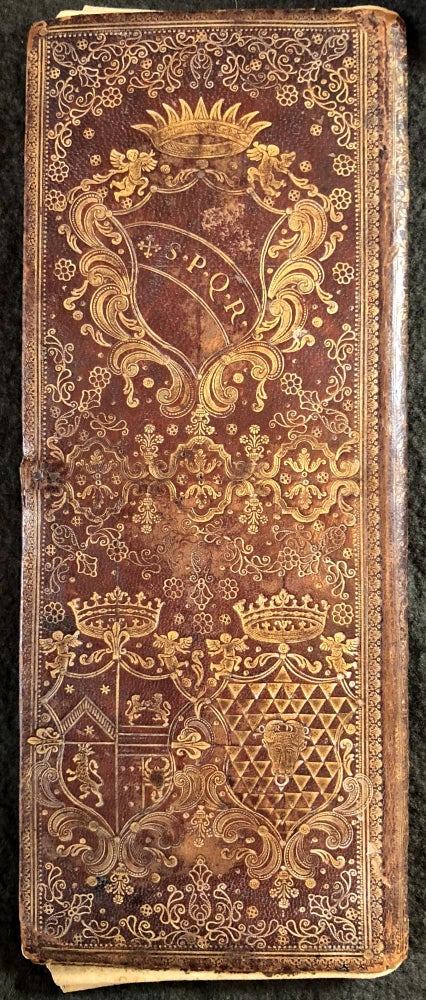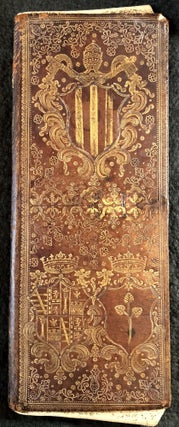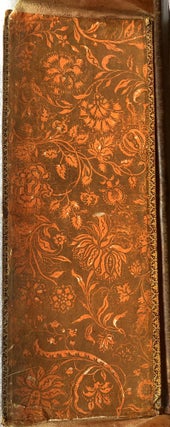Gold-tooled morocco portfolio with papal arms. [Italy, probably Rome, late 17th century].
An agenda-format portfolio or letter-holder of gold-tooled brown goatskin or hair sheep (334 x 135 mm.), both covers with dense pointillé tools surrounding a large coat of arms in the upper compartment, consisting of the Papal arms on the front cover (the original Papal shield overlaid by a brown goatskin onlay with the arms of Pope Benedict XIV) and the arms of the city of Rome on the lower cover, and two small crowned coats of arms in the lower compartment; decorative tools including several small angels, flowers in vases, 8-petalled blossoms, small stars and blossoms, and pointillé arabesques, blind horizontal and vertical lines (from the finisher’s transfer of the design?) visible on the covers; holes for a single fore-edge strap with clasp (lacking), backstrip with scrolling floral tooling, turn-ins gold-tooled, liners of orange gilt floral Dutch-gilt paper (Brokatpapier) with carnations, poppies and other flowers, original tan reversed leather gussets. Some rubbing and a few small chips or holes, spine tooling faded and with some abraded areas, upper cover color faded, a few scrapes and some rubbing to paper liners.
A densely gold-tooled portfolio. This uncommon and evocative object, produced by bookbinders, may have served to carry official documents. The original arms which are hidden beneath a later onlaid shield bearing the arms of Pope Benedict XIV (1740-1758) are presumably those of an earlier Pope, possibly his immediate predecessor Clement XII (1730-1740), but the gold-tooling of the portfolio is earlier. The four smaller coats of arms appear to all belong to prominent Roman families (two remain unidentified). In the lower left quadrant of the front cover are the arms of Carlo Camillo II Massimo (1620-1677), a wealthy and prominent politician and numismatist (and heir to an important art collection), named cleric of the Camera Apostolica in 1651 and Cardinal in 1670, or possibly of a younger member of his family. The unidentified coat of arms in the lower right quadrant contains a single branch with three leaves. On the rear cover, the unidentified coat of arms in the lower left quadrant incorporates in the right half the arms of the Amolara de Annibaldi family. The arms on the right, with the buffalo head and the word “Ordo,” are those of the family Bufalo Cancellieri.
Stylistically the pointillé tooling is reminiscent of 17th-century French bookbinding. The same angel tools and identical pointillé arabesque tools are found on an empty Roman binding in the British Library, Henry Davis Gift 857 (Foot, The Henry Davis Gift, vol. III, no. 375), dated to ca. 1700, which also bears a similar though not identical SPQR shield, and the characteristic faint blind-impressed lines found on many Roman binidngs of this period.
The fine orange-on-gold block-printed “Brokatpapier” may have been applied a bit later. It appears to come from the workshop of Georg Christoph Stoy of Augsburg, allegedly active from 1709: a very similar paper, signed by Stoy, is reproduced by Haemmerle, p. 21. Stoy (1670-1750) was “the most important and versatile producer of decorative paper in Europe ... The papers of his firm are of high or the highest quality...” (Haemmerle, Buntpapier, p. 129). At first glance the portfolio seems to re-use a bookbinding, but the inner covers have gold-tooling on both the inner and outer edges, which would not have been the case for a binding.
No longer available
Status: On Hold



